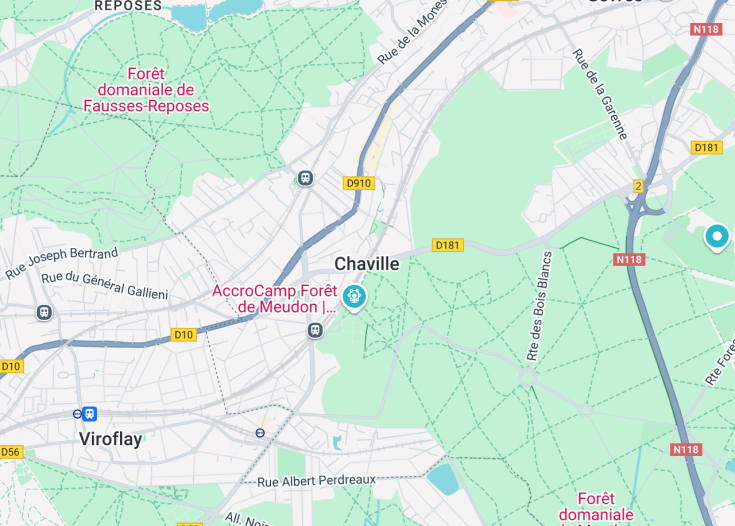Nestled between Versailles and Paris, Chaville is a serene treasure trove of natural beauty and rich history. It is renowned for its vast forests, particularly the Meudon and Chaville forests, which offer an array of outdoor activities like hiking and cycling. This quaint town is steeped in heritage, with landmarks like the 12th Century Church of Saint-Nicolas. Chaville’s proximity to Paris makes it an ideal destination for tourists seeking tranquility while being close to major attractions.
To best experience Chaville, time your visit during spring or autumn to enjoy its scenic landscapes in mild weather.
Do not miss a leisurely walk through the historic center which offers insights into Chaville’s cultural and architectural charm.
Top things to do & see in Chaville
Select the following sights and activities to discover best tickets and tours available in Chaville.
Chaville: A Serene Commune Amidst Urban Bustle
| Country | France |
| Time in Chaville | GMT+1 |
| Language spoken | French |
| Population | 20,264 (source: latest municipal report) |
| Currency | Euro (€) (EUR) |
| Airports |
|
Chaville is a charming suburban commune nestled between Paris and Versailles. With its abundance of green spaces and proximity to French cultural landmarks, Chaville offers a unique blend of urban convenience and countryside serenity. Historically, Chaville stood as a strategic point during the Franco-Prussian War and has evolved over the centuries, maintaining an elegant balance between its rich past and modern influences. It is especially known for its expansive forests, namely the Meudon and Fausses Reposes woods, which are popular with nature lovers and history enthusiasts alike. The town also takes pride in its sustainable urban planning and community-oriented lifestyle, making it a model for suburban development in France.
Where is Chaville?
Chaville is situated in the Île-de-France region, between the capitals of Paris and Versailles.
Distances:
| Route | Distance by car | Time by car |
|---|---|---|
| Paris to Chaville | 8 miles / 12.9 km | 20 minutes |
| Versailles to Chaville | 3.7 miles / 6 km | 10 minutes |
| Orly Airport to Chaville | 15.6 km / 9.7 mi | 25 minutes |
What is Chaville famous for?
Chaville is renowned for its vast, historical woodlands and parks. It serves as a green haven for city dwellers from nearby Paris and Versailles, offering numerous trails, scenic vistas, and a tranquil escape from urban life.
History
Chaville, a picturesque town located in the Île-de-France region of France, boasts a rich tapestry of history dating back to its earliest days. Nestled between Versailles and Paris, this serene locality has evolved through several fascinating epochs, each adding a unique layer to its cultural and historical landscape.
Prehistory to Middle Ages (Before 1000 AD)
The area now known as Chaville was originally inhabited by Celtic tribes, who were eventually assimilated into Roman territories as the empire expanded. Post the fall of the Roman Empire, during the early medieval period, the region saw a flux of royal and noble activities, primarily hunting, due to its dense forests and favorable location.
Renaissance to French Revolution (1000 AD – 1789 AD)
During the Renaissance, Chaville began to develop as a village, benefiting from its proximity to the royal palace of Versailles. Its strategic location made it a frequent stopover for nobles and royalty traveling between Paris and Versailles. In the 17th century, several prominent French families established estates in Chaville, leading to significant economic and social development. However, the town was not immune to the upheavals of the French Revolution, which saw the transformation of its social fabric and land ownership.
19th Century Industrialization (1789 AD – 1900 AD)
The advent of the industrial age brought new changes to Chaville. The construction of the Paris-Versailles railway in the 19th century transformed the town into an accessible suburban area. This development led to increased population growth and the emergence of new industries, shaping Chaville into a significant commuter town with a robust economic structure.
20th Century to Present Day (1900 AD – Present)
The 20th century was marked by further suburbanization and modernization, with improvements in infrastructure such as roads and public services. Post-World War II, Chaville saw a reconstruction phase, leading to the development of new residential areas and the enhancement of local amenities. Today, Chaville is known for its green spaces, such as the Forêt de Meudon and cultural sites, maintaining a blend of historical charm and modern living.
Visit Chaville
What to see and do in Chaville, France.
Chaville, nestled amidst lush greenery and historical sites, offers a variety of attractions and activities for visitors. Exploring the Forêt de Meudon presents a perfect opportunity for hiking and nature walks. The town’s historical churches, like Sainte Marie-Madeleine, provide a glimpse into its architectural heritage. Additionally, the local markets offer a taste of regional products and crafts.
Festivals and Local Culture
Chaville hosts several local festivals and events, particularly notable are the Spring and Autumn Festivals. These events, occurring respectively at the equinoxes, celebrate the rich local culture and community spirit through music, dance, and food, reflecting the town’s vibrant social fabric.
Best time to visit Chaville
The best times to visit Chaville are during the spring and autumn months when the weather is mild and the natural scenery is at its most beautiful. These periods provide an ideal climate for exploring the outdoor attractions and participating in local festivals.
Is Chaville worth visiting?
Chaville offers a unique blend of historical richness and natural beauty, making it a worthwhile visit for those appreciate quiet, picturesque locales with easy access to major cities like Paris and Versailles. However, visitors looking for a bustling nightlife or extensive shopping experiences might find it less appealing. The town’s small scale and tranquil environment are its charm, but also its limitation for those seeking more vibrant urban activities.









